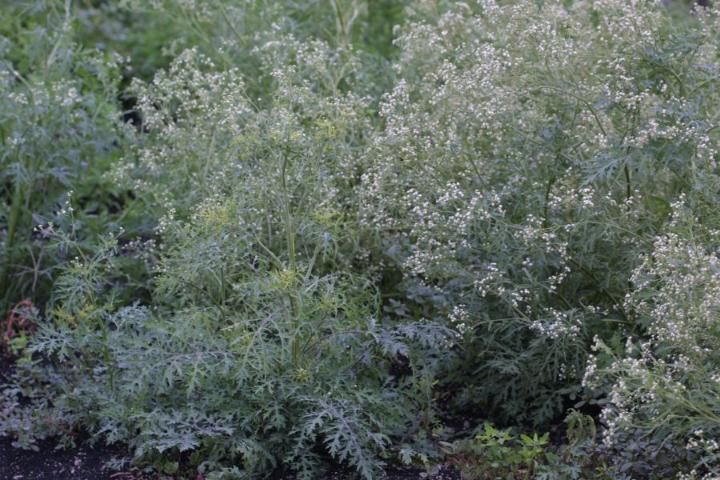Ragweed parthenium (Parthenium hysterophorus) is an herbaceous plant of tropical and subtropical environments in the Asteraceae family native to Central and South America. This species is distributed from Florida to Michigan and from Massachusetts to Texas, but it is more common in the southern United States. In Florida, it is found along ditch and canal banks, on roadsides and railroads, near buildings, and in poorly maintained lawns and disturbed sites. Presently, it is encroaching into adjoining cultivated fields in many areas of south Florida. Ragweed parthenium is considered a noxious weed in many parts of the world because of its allelopathic effect on other plants and the health risks it poses to humans. It causes allergic contact dermatitis, rhinitis, and respiratory problems in sensitive humans.
Biology and Life Cycle
Ragweed parthenium is an erect-branched annual that can grow and flower throughout the year in subtropical environments. It will predominantly germinate in the spring and early summer and flower 4 to 8 weeks after germination, reaching a height of 1 to 3 ft. This species is a prolific seed producer capable of producing 19,000 seeds per ft2. Buried seeds in the soil may remain viable for more than 2 years, indicating that it can have a substantial persistent seed bank.
Seedling
The cotyledons have a rounded paddle shape, measure 0.1 to 0.2 inches long, and are borne on short stalks less than an inch long. The first true leaves are egg-shaped and covered in fine, white hairs. Older leaves become increasingly lobed and deeply divided. The seedling develops a basal rosette (Figure 1) with leaves 3 to 8 inches long and 1 to 2 inches wide, pinnatifid to bipinnatifid, with hair on both leaves and stems.

Credit: D. C. Odero, UF/IFAS
Mature Plant
Stems are erect and hairy. They are panicularly branched and covered by longitudinal lines with a deep taproot (Figure 2). Leaves are alternate and pinnatifid to usually bipinnatifid. The lower leaves form a basal rosette, and the upper leaves can be either entirely or slightly lobed. Stems and leaves are covered in short, white hairs (Figure 3). Flower heads occur in clusters at the top of the plant, are borne on short stalks, and arise from the leaf forks. The densely haired flowers are small and white and form a 5-side dish shape measuring 0.2 to 0.4 inches across. Long white flowerlets (ray flowers) are present in the corners. Flower heads become hard and brown as they mature. The seeds measure less than 0.1 inch long, have a flattened and narrow-diamond shape, and are colored striped grey to black.

Credit: D. C. Odero, UF/IFAS

Credit: D. C. Odero, UF/IFAS

Credit: D. C. Odero, UF/IFAS
Control
Control options for ragweed parthenium are limited in non-cropland. Mowing is not an effective tool for control because it results in rapid regeneration, which is quickly followed by flowering and abundant seed production. Ragweed parthenium control can be achieved by using diquat (several trade names) at 1 to 2 quarts per acre (equivalent to 1.25%–2.5% v/v), but control varies with applied rate and stage of development. Since diquat is a contact herbicide, complete coverage of ragweed parthenium is essential to achieve adequate control. Application of diquat to large and stressed plants will not provide satisfactory control. For best results, diquat should be applied to ragweed parthenium when it is at the rosette stage of development. An addition of a nonionic surfactant containing more than 75% surface active agent at 0.25 to 0.5% v/v increases the efficacy of diquat. Saflufenacil (Sharpen) applied as a burndown can effectively control ragweed parthenium at any stage of development at 0.5 to 2 fluid ounces per acre (equivalent to 0.02%–0.08% v/v). For optimum burndown, methylated seed oil (1% v/v) plus either ammonium sulfate (1%–2% w/v) or urea ammonium nitrate (1.25%–2.5% w/v) must be used. Additionally, application of 2,4-D at 1% v/v may provide some control in the rosette stage. If 2,4-D is used, the Florida Organo-Auxin Herbicide Rule (see https://edis.ifas.ufl.edu/wg051) must be consulted prior to application in order to prevent spray drift to sensitive crops. Presently, glyphosate (several trade names) is used in other regions for ragweed parthenium control, but it does not provide any control of glyphosate resistant biotypes in south Florida.
References
Adkins, S.W. and M. S. Sowerby. 1996. "Allelopathic potential of the weed, Parthenium hysterophorus L., in Australia." Plant Protection Quarterly 11: 20–3.
Anonymous. 2003. "Weed Management Guide Parthenium Weed – Parthenium hysterophorus." Accessed September 17, 2018. http://www.environment.gov.au/biodiversity/invasive/weeds/publications/guidelines/wons/p-hysterophorus.html
Bryson, C. T., and M. S. DeFelice. 2009. Weeds of the South. Athens, GA: University of Georgia Press.
Fernandez, J. V., D. C. Odero, G. E. MacDonald, and J. Ferrell. 2015. "Confirmation, characterization, and management of glyphosate-resistant ragweed parthenium (Parthenium hysterophorus L.) in the Everglades Agricultural Area of south Florida". Weed Technology 29: 233–242.
Joshi, S. 1991. "Biocontrol of Parthenium hysterophorus L." Crop Protection 10: 429–31.
Khosla, S. N. and S. N. Sobti. 1979. "Parthenium — a national health hazard, its control and utility — a review." Pesticides 13: 121–7.
Navie, S. C., F. D. Panetta, R. E. Mcfadyen, and S. W. Adkins. 1998. "Behaviour of buried and surface-sown seeds of Parthenium hysterophorus." Weed Research 38: 335–41.